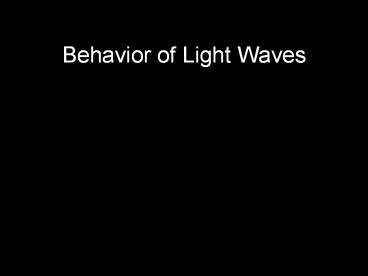Behavior of Light Waves - PowerPoint PPT Presentation
Title:
Behavior of Light Waves
Description:
Behavior of Light Waves S8P4.b Describe how the behavior of light waves is manipulated causing reflection, refraction, diffraction, and absorption Manipulate to ... – PowerPoint PPT presentation
Number of Views:592
Avg rating:3.0/5.0
Title: Behavior of Light Waves
1
Behavior of Light Waves
2
S8P4.b
- Describe how the behavior of light waves is
manipulated causing reflection, refraction,
diffraction, and absorption - Manipulate to affect or control
3
Whats It Mean?
- Light waves change when they hit materials.
- The way light waves change depends on the
material the waves hit. - Describe how changes in light waves cause
reflection, refraction, diffraction, and
absorption.
4
Getting the Idea
- Waves do not always travel in one direction they
often bounce off one surface and then travel in
another direction. - Waves can continue to change direction long after
the original source of the energy has stopped.
5
- When sound waves demonstrate this property, you
hear echoes. - Light waves can also bounce off surfaces and
change the direction in which they travel. - When any type of wave hits and obstacle or passes
from one medium to another, it is possible that
the wave will change in speed, direction, or
shape.
6
Reflection
- Occurs when a wave bounces back after striking a
barrier. - Examples of barriers include mirrors and shiny
pieces of metal. - Water waves, light waves, sound waves, and heat
all can be reflected. - An echo is a reflected sound wave.
- Reflection is the property of light that allows
you to see yourself in a mirror.
7
Law of Reflection
- States that the angle of incidence is equal to
the angle of reflection.
8
Absorption of Light
- A beam of light becomes dimmer partially because
of absorption and scattering.
- Absorption is the transfer of energy to particles
of matter.
9
- When you shine a flashlight in the air, the air
particles absorb some of the energy form the
light. This causes the light to become dim.
- The farther the light travels from the
flashlight, the more it is absorbed by air
particles.
10
Scattering of Light
- The releases of light energy by particles of
matter that have absorbed energy. - When the light is released, it scatters in all
directions. - Light from a flashlight is scattered out by air
particles. The scattered light allows you to see
objects outside the beam. However, because light
is scattered out from the beam, the beam becomes
dimmer.
11
Why is our sky blue?
- The gases and other particles that make up our
atmosphere scatter the color blue more than the
other six colors.
12
Refraction
- The bending of a wave as it passes at an angle
from one medium to another.
A hands lens makes objects appear larger because
of refraction.
13
Refraction
- The bending of a wave as it passes at an angle
from one medium to another. - Refraction of light takes place when light passes
from one medium having one density to a medium
with a different density. - The refraction of light occurs because the speed
of light varies depending on the material that it
passes.
14
Light travels more slowly through the glass and
water than it does air. Therefore, it refracts
as it passes at an angle from air to glass, to
water or from water, to glass, to air.
15
Optical Illusions
- Stare at the four dots in the center of this page
for about 30 seconds. Try not to blink. Then
lean back, look at the ceiling and blink your
eyes a few times. Did you see Jesus?
16
(No Transcript)
17
Refraction and Color Separation
White light can be separated into different
colors (Roy G. Biv) by refraction.
- When white light is refracted, it separates into
different colors. - Color separation during refraction is responsible
for the formation of rainbows.
18
What causes a rainbow?
- Rainbows are created when sunlight is refracted
by water droplets in the atmosphere.
19
Diffraction
- refers to the bending, spreading, and
interferences of waves when they go through a
narrow opening. - Occurs with any type of wave.
- A wave is diffracted more when its wavelength is
similar in size to the barrier or opening.
20
Transmission
- The passing of waves through a medium.
- Example A radio wave (electromagnetic wave) is
produced at the radio station. The wave travels
from the radio stations transmitter out in all
directions at the speed of light. Your radio
detects the EM































